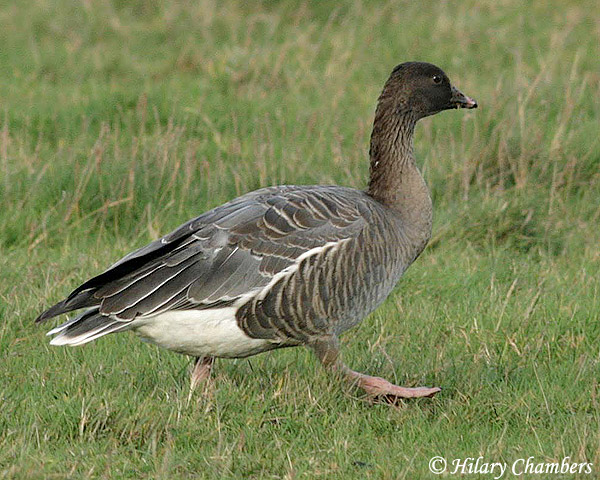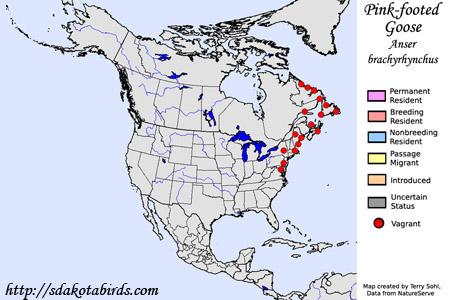| Length: 24 - 30 inches | Wingspan: 54 - 64 inches | Seasonality: Non-resident in South Dakota |
| ID Keys: Grayish brown overall, white rump, pink feet, and short dark bill with pinkish center band | ||
 The
Pink-footed Goose is a medium sized goose that breeds in Greenland, Iceland,
and Svalbard, and winters in parts of Northern Europe. Despite
breeding in Greenland, they were once extremely rare vagrants to eastern
Canada and the northeastern United States. However, in recent decades,
they have been spotted more and more frequently overwintering in the
northeastern United States.
The
Pink-footed Goose is a medium sized goose that breeds in Greenland, Iceland,
and Svalbard, and winters in parts of Northern Europe. Despite
breeding in Greenland, they were once extremely rare vagrants to eastern
Canada and the northeastern United States. However, in recent decades,
they have been spotted more and more frequently overwintering in the
northeastern United States.
Habitat: During the summer breeding season, they often use cliffs and rocky crags for nesting, also using open tundra near freshwater ponds and lakes. During migration and in winter, they can be found in estuaries, lakes, and ponds, particularly in areas near agricultural fields and grasslands for foraging.
Diet: Feeds almost exclusively on vegetative material. Feeds on sedges, grasses, berries, leaves, lichen, and moss during the summer breeding season. In winter, they will often feed in agricultural fields, feeding on waste grain and tubers. They are sometimes considered agricultural pests given their propensity to feed on root crops such as potatoes and beets.
Nesting: Pink-footed Geese nest on both rocky cliffs and crags, as well as raised hummocks in tundra areas. When the young hatch, parents and young move to nearby freshwater lakes and ponds. The young find their own food, but are protected by the parents until they fledge.
Song: High-pitched honking, most often heard while in flight.
Migration: Breeds in Greenland, Iceland, and Svalbard. Winters in parts of northern Europe and Asia.
Interactive eBird Map: Click here to access an interactive eBird map of Pink-footed Goose sightings
Similar Species: Closely related to the Bean Goose and Greater White-fronted Goose.
Conservation Status: There are no major threats to populations of the Pink-footed Goose, and the species is currently listed as a species of "Least Concern" by the IUCN.
Further Information: 1) Royal Society for the Protection of Birds (RSPB) - Pink-footed Goose
2) Internet Bird Collection - Pink-footed Goose
3) BirdGuides.com - Pink-footed Goose
Photo Information: Photo taken by Hilary Chambers - Photo licensed through Creative Commons Attribution No-Derivatives 2.0 License
| Click below for a higher-resolution map |
 |
| South Dakota Status: Non-resident in South Dakota |
Additional Pink-footed Goose Photos (coming soon!!)
